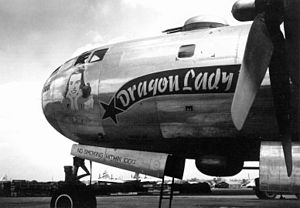| 793d Bombardment Squadron | |
|---|---|
 793d Bombardment Squadron Boeing B-29-55-BW Superfortress 44-69663 | |
| Active | 1943-1946 |
| Country | United States |
| Branch | United States Army Air Forces |
| Type | Bombardment |

B-29-25-MO Superfortress 42-65276. 793d Bombardment squadron, Kharagpur Airfield, India, 1944
The 793d Bombardment Squadron is an inactive United States Air Force unit. Its last assignment was with 468th Bombardment Group stationed at Roswell Army Airfield, New Mexico. It was inactivated on 31 March 1946.
History[]
Established in March 1943 as one of the first B-29 Superfortress squadron; however no B-29s were yet available for operational use. Trained with B-24 Liberators and B-17 Flying Fortresses throughout 1943. Received early model B-29s and prototype YB-29s beginning in August 1943, however aircraft were still undergoing development and were frequently modified by Boeing technicians in the field while the squadron was undergoing training in Kansas.
Deployed to India in early 1944; several aircraft breaking down en route via South Atlantic Transport route from Florida to Brazil then to Liberia; across central Africa and Arabia, arriving in Karachi, India in March 1944. Arrived at converted B-24 airfield in eastern India in mid-April 1944. Aircraft still undergoing modifications while transporting munitions and fuel to forward airfield in central China; staging first attacks on Japanese Home Islands since the 1942 Doolittle Raid. Lack of logistical support limited number of attacks on Japan from Chinese staging airfields; squadron also attacked strategic enemy targets in Thailand; Indochina and Malay Peninsula.
Moved to West Field (Tinian), Tinian, in the Mariana Islands of the Central Pacific Area in January 1945 and assigned to XXI Bomber Command, Twentieth Air Force. It's mission was the strategic bombardment of the Japanese Home Islands and the destruction of its war-making capability. Flew "shakedown" missions against Japanese targets on Moen Island, Truk, and other points in the Carolines and Marianas. The squadron conducted combat missions over Japan participating in wide area firebombing attacks, but the first ten day blitz resulting in the Army Air Forces running out of incendiary bombs. Until then the squadron flew conventional strategic bombing missions using high explosive bombs.
The squadron continued attacking urban areas with incendiary raids until the end of the war in August 1945, attacking major Japanese cities, causing massive destruction of urbanized areas. Also conducted raids against strategic objectives, bombing aircraft factories, chemical plants, oil refineries, and other targets in Japan. The squadron flew its last combat missions on 14 August when hostilities ended. Afterwards, its B 29s carried relief supplies to Allied prisoner of war camps in Japan and Manchuria Squadron was largely de-mobilized on Saipan during the fall of 1945. Was reoganized as part of continental Air Forces, Fourth Air Force at March Field, California in November 1945, being manned and equipped with low-hour B-29s returned from the Central Pacific. It later was transferred to the new Strategic Air Command on 21 March 1946, being one of SAC's initial bombardment squadrons. Demobilization, however, was in full swing and the unit turned in its aircraft and was inactivated on 1 October 1946.
Operations and decorations[]
- Combat Operations: Combat in CBI, 5 Jun 1944-29 Mar 1945, and Western Pacific, 5 Mayh-14 Aug 1945.
- Campaigns: Combat in CBI, 5 Jun 1944-29 Mar 1945, and Western Pacific, 5 Mayh-14 Aug 1945.
- Decorations: Distinguished Unit Citation Yawata, Japan, 20 Aug 1944; Tokyo and Yokohama, Japan, 23, 25 and 29 May 1945; Takarazuka, Japan, 24 Jul 1945.
Lineage[]
- Constituted 793d Bombardment Squadron (Heavy) on 19 May 1943
- Activated on 1 Aug 1943
- Redesignated 793d Bombardment Squadron (Very Heavy) on 20 Nov 1943
- Inactivated on 31 Mar 1946.
Assignments[]
- 468th Bombardment Group, 1 Aug 1943-31 Mar 1946
Stations[]
- Smoky Hill Army Airfield, Kansas, 1 Aug 1943-12 Mar 1944
- Kharagpur Airfield, India, c. 13 Apr 1944-4 May 1945
- West Airfield, Tinian, 7 May-15 Nov 1945
- Fort Worth Army Air Field, Texas, 1 Dec 1945
- Roswell Army Air Field, New Mexico, 9 Jan-31 Mar 1946
Aircraft[]
- B-29 Superfortress, 1943–1946
References[]
This article incorporates public domain material from the Air Force Historical Research Agency website http://www.afhra.af.mil/.
- Maurer, Maurer, ed (1982) [1969]. Combat Squadrons of the Air Force, World War II (reprint ed.). Washington, DC: Office of Air Force History. ISBN 0-405-12194-6. LCCN 70605402. OCLC 72556. http://www.airforcehistory.hq.af.mil/Publications/fulltext/combat_sq_of_the_af_wwii.pdf.
External links[]
| ||||||||||||||||||||||
The original article can be found at 793d Bombardment Squadron and the edit history here.
